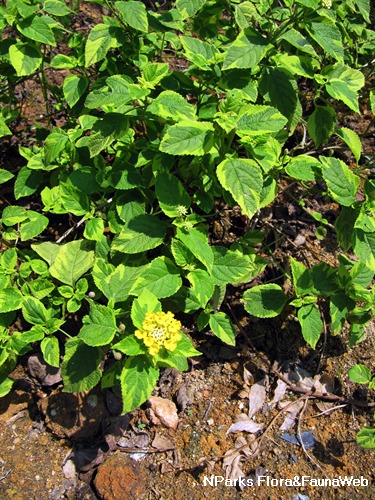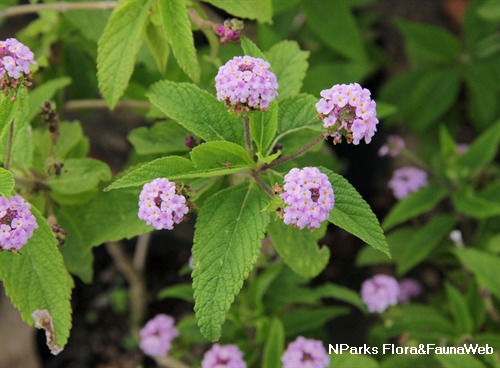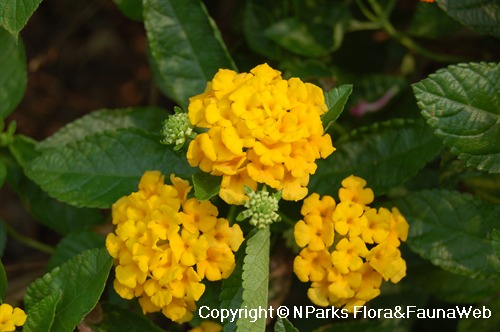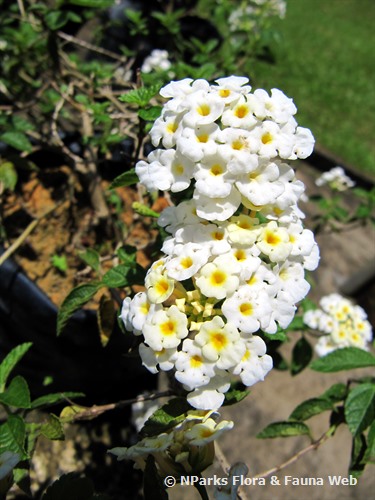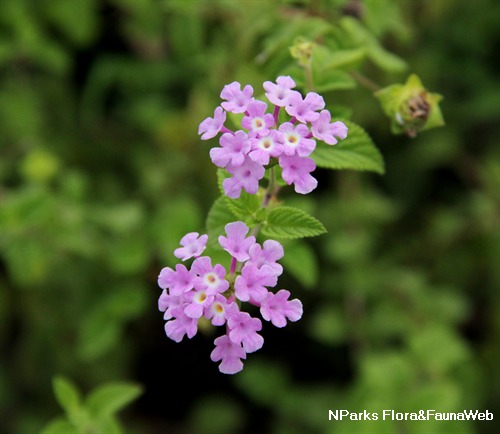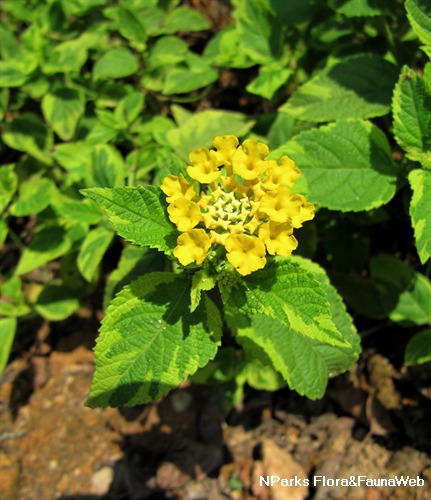
Back
Lantana camara 'Samantha'
| Family Name: | Verbenaceae |
| Common Name: | Lemon Swirl, Samantha Lantana, 花叶马缨丹 |
Name
Classifications and Characteristics
| Plant Division | Angiosperms (Flowering Seed Plants) (Dicotyledon) |
|---|---|
| Plant Growth Form | Shrub |
| Lifespan (in Singapore) | Perennial |
| Mode of Nutrition | Autotrophic |
| Plant Shape | Compact |
Biogeography
| Native Habitat | Terrestrial |
|---|---|
| Preferred Climate Zone | Tropical |
Description and Ethnobotany
| Growth Form | Evergreen shrub with a mounding or semi-trailing growth habit. |
|---|---|
| Foliage | Opposite leaves are approximately ovate and slightly asymmetrical with serrate leaf margin. Variegated leaves are dark green in the center with yellowish, irregular patches along the leaf margin. Leaves are deeply veined with a rugose surface that is covered in rough, irritating hairs. |
| Flowers | Salverform flowers are bright yellow. Flowers are arranged in rounded clusters known as umbels (2.5 - 3.8 cm wide). Plants are free flowering in the tropics. |
| Fruit | Fleshy, pitted fruits known as drupes are initially bluish green and then darken to purplish black. The seeds are typically not viable, because 95% of its pollen is sterile. |
| Cultivation | This cultivar is easy-to-grow and has a fast growth rate. It can tolerate a wide variety of soil types, but it will grow best in acidic to neutral, well-draining soil that is kept moist. Specimens should be planted 45 - 60 cm apart. After establishment, it is drought- and heat-tolerant. It will flower best under full sun. The green, unripe fruits are toxic upon ingestion, so it is best to prevent fruiting by promptly removing spent flowers. This cultivar has a compact, bushy form, so only light pruning is needed. Potted plants will flower better if they are allowed to become slightly rootbound. If whiteflies become a problem, spray the upper and lower leaf surfaces with a pesticide containing neem or pyrethrum. It is also susceptible to scale insects and leaf chewing insects. |
Landscaping Features
| Landscaping | The 'Samantha' cultivar is planted for its abundant, bright yellow flowers and variegated leaves. It is often planted in flower beds or as a border. Consider using this cultivar for window boxes, hanging baskets or mixed plantings. It is ideal for butterfly gardens as a nectar plant. It is also an excellent choice for water-conscious gardeners, as it is highly drought tolerant. |
|---|---|
| Desirable Plant Features | Ornamental Flowers, Ornamental Foliage, Fragrant (Flowers) |
| Landscape Uses | Container Planting, Coastal, General, Flowerbed / Border, Suitable for Hanging Baskets |
| Thematic Landscaping | Butterfly Garden |
Fauna, Pollination and Dispersal
| Fauna Pollination Dispersal Associated Fauna | Butterfly-Attracting |
|---|---|
| Pollination Method(s) | Biotic (Fauna) (Insects (Butterfly, Moth)) |
Plant Care and Propagation
| Light Preference | Full Sun |
|---|---|
| Water Preference | Moderate Water |
| Plant Growth Rate | Fast |
| Rootzone Tolerance | Fertile Loamy Soils, Well-Drained Soils, Easy to Grow, Drought Tolerant |
| Maintenance Requirements | Low |
| Propagation Method | Stem Cutting |
Foliar
| Foliage Retention | Evergreen |
|---|---|
| Mature Foliage Colour(s) | Green, Yellow / Golden |
| Mature Foliage Texture(s) | Hairy / Hirsute |
| Foliar Type | Simple / Unifoliate |
| Foliar Arrangement Along Stem | Opposite |
| Foliar Shape(s) | Non-Palm Foliage (Ovate, Asymmetrical) |
| Foliar Venation | Pinnate / Net |
| Foliar Margin | Serrate / Toothed |
| Foliar Apex - Tip | Acute |
| Foliar Base | Rounded / Obtuse |
Floral (Angiosperm)
| Flower & Plant Sexuality | Bisexual Flowers |
| Flower Colour(s) | Yellow / Golden |
|---|---|
| Flower Symmetry | Bilateral |
| Individual Flower Shape | Salverform |
| Flowering Period | Free-Flowering |
Fruit, Seed and Spore
| Mature Fruit Colour(s) | Black |
|---|---|
| Fruit Classification | Simple Fruit |
| Fruit Type | Fleshy Fruit , Drupe |
Image Repository
Others
| Master ID | 885 |
|---|---|
| Species ID | 2179 |
| Flora Disclaimer | The information in this website has been compiled from reliable sources, such as reference works on medicinal plants. It is not a substitute for medical advice or treatment and NParks does not purport to provide any medical advice. Readers should always consult his/her physician before using or consuming a plant for medicinal purposes. |

